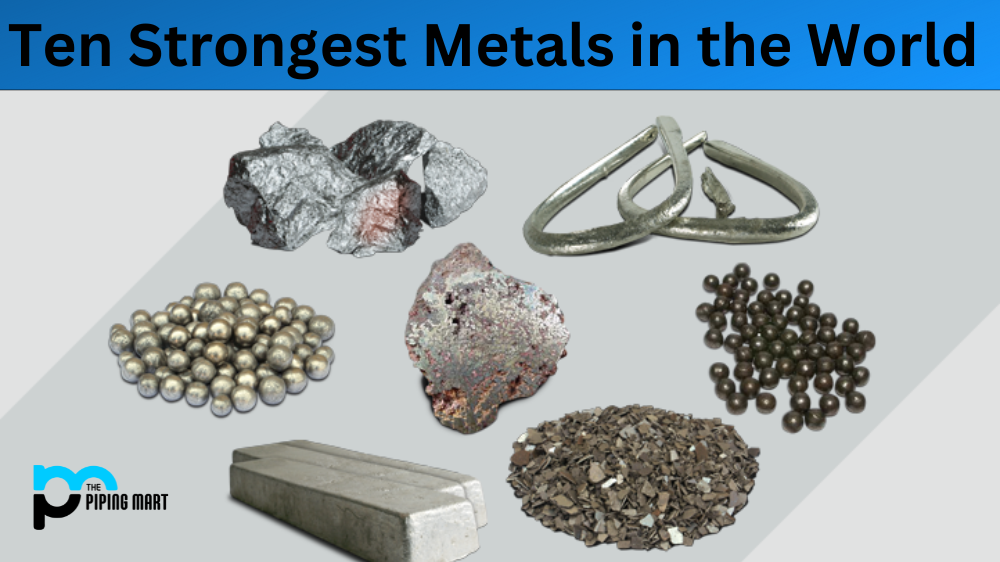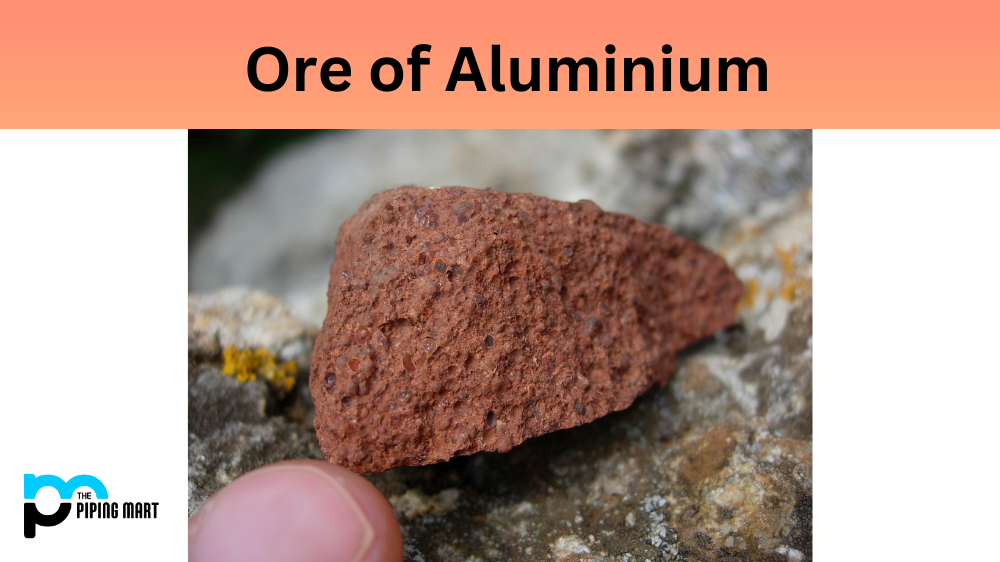Have you ever wondered what are the strongest metals in the world? Metals have been used throughout history for a variety of purposes, from creating weapons to constructing buildings. But not all metals are created equal – some are much stronger than others. In this blog post, we’ll be exploring the top ten strongest metals in the world. Keep reading to learn more!
Top Strongest Metals
Tungsten
Tungsten is an extremely hard metal with an extremely high melting point (over 6,000°F). Tungsten has a very high tensile strength and can be used for a variety of applications, such as cutting tools, armor plating, jewelry, radiation shielding, and even golf clubs! It’s also resistant to corrosion and heat damage.
Chromium
Chromium is already a common element in our world – from the gold-colored accents on cars to its vital role in steel production, practically no industry is untouched by it. But beyond rust-resistant alloys and metallic decorations, Chromium has many more practical uses. It provides an essential mineral for human health, helping with metabolic processes like glucose balance and metabolism of fatty acids. With its influence over insulin sensitivity, it’s also instrumental in maintaining balanced levels of cholesterol in the blood. As such, getting adequate Chromium from food sources or supplements should be a part of any well-rounded diet. Even more excitingly, research currently underway shows Chromium may have further use cases as an anti-inflammatory agent whose effects may extend to cancer treatments.
Titanium
Titanium is one of the most popular metals used today and is renowned for its strength. It’s strong enough that it can be used in place of steel in many applications, resulting in lighter products without sacrificing strength. Titanium has a high strength-to-weight ratio, a low density, and excellent corrosion resistance. It’s also non-magnetic and has good thermal stability.
Gadolinium
Gadolinium is an earth metal known for its unique properties. It has the highest thermal neutron capture cross-section of any isotope and is frequently used in nuclear reactors. As a result, it can be utilized to create shielding that absorbs neutrons within the reactor and helps to prevent radiation leakage. Gadolinium also has electrical and magnetic qualities, which make it useful in other industrial applications, including being added to MRI scans as a contrast medium to better illustrate soft tissues and organs of the body on the image. It also takes advantage of these properties in emerging technologies such as electric vehicles since gadolinium can store large amounts of energy and power components that require high heat tolerance. Gadolinium’s abundant use and versatility demonstrate why it has become so important across numerous industries today.
Iron
Iron is a remarkable and versatile element essential for sustaining life on Earth. It’s the properties of iron that make it so useful; its malleability, ductility, and strength make it ideal for construction materials and in manufacturing. In its purest form, iron can be found in meteorites, however, in its more practical form, it is processed from natural ores like hematite to create strong alloys such as steel. As humanity’s most used metal, iron has been at the center of numerous civilizations’ growth thanks to its abundance, cost-effectiveness, and hardiness. Today, we continue to utilize the power of iron in a variety of ways, including jewelry, industrial machines, and medical treatments such as anti-tumor applications or bloodstream oxygenation.
Vanadium
Vanadium is an amazing, silvery-white metal with many notable characteristics. Its malleability and ductile nature make it easy to shape and form without breaking or bending while still remaining strong and hard. Vanadium’s ability to resist corrosion makes it a great choice in areas where material breakdown due to exposure to the elements may be an issue. Due to its high thermal reflectivity, vanadium is often used as a very efficient source of insulation for thermal applications. It has even been proposed for use in reducing airplane emissions due to its incredibly low levels of radioactivity–lower than any other currently known element! All this goes to show what an invaluable asset vanadium can be in modern society.
Lutetium
Lutetium is a rare earth metal, not typically found in everyday items, despite its properties that make it an ideal component of various technologies, including LED lighting. Its relative stability allows it to hold up through rigorous conditions, and its unique structure makes it attractive for applications requiring electrical components. Lutetium has been used in nuclear reactors to help control subatomic reactions and, more recently, as a potential cancer treatment due to its ability to concentrate radioactivity without attacking healthy cells. Though its uses may be limited at this time, research into this valuable element promises promising results for the future.
Zirconium
Zirconium is a silvery-white metallic element with a low density and high corrosion resistance, making it an ideal material for use in nuclear power reactors. It also has numerous applications in other areas, such as chemical and mechanical engineering and biomedical engineering. For example, zirconium alloys are used to produce surgical instruments, dental implants, and orthopedic implants due to its superior strength and biocompatibility. Additionally, the oxide of zirconium forms in the surface of otherwise brittle ceramics giving them enhanced durability. Furthermore, its ability to absorb neutrons makes it a valuable tool for fuel cell manufacture and radiation shielding for medical imaging applications. Clearly, the unique properties of zirconium make it an immensely useful element in a variety of fields!
Osmium
Osmium is an extremely dense metal that’s also incredibly rare. It has the highest density of all naturally occurring elements, and its name comes from the Greek word for “smell.” Osmium is primarily used to make hardening alloys, but it also has many other applications. For example, it can be used to aid in cooling rocket engines and to produce medical equipment such as medical implants and prosthetic joints. Because of its rarity, osmium is incredibly valuable; in fact, it can be worth more than twice the price of gold and over 12 times that of silver. In short, osmium is a powerful metal with amazing properties – one that should be respected and appreciated!
Tantalum
Tantalum is a rare, hard, blue-gray metal that is highly heat resistant and extremely ductile. It’s used in making capacitors and other electronic components because of its ability to hold an electrical charge. Tantalum is also added to alloys to increase their strength and resistance to corrosion, making it the metal of choice for chemical processing and medical applications. Its wide range of uses gives tantalum great versatility for both industry and consumer demand. Few other metals can match its unique combination of durability and reliability, with tantalum proving itself to be an indispensable metal for modern life.
Steel
The word “steel” is often used to refer to any metal alloy that contains iron and carbon as its primary components. Steel is incredibly strong and durable, making it one of the most popular building materials in use today. It’s also relatively inexpensive compared to other metals and can withstand extreme temperatures without losing its strength or durability.
Inconel
Inconel is an incredibly strong nickel-based alloy that is known for its incredibly high melting point (up to 2200°F). Inconel has excellent oxidation resistance at elevated temperatures making it perfect for aerospace applications where it can be exposed to extreme conditions without compromising its strength or durability. Additionally, Inconel has superior corrosion resistance, which makes it ideal for chemical processing plants or other areas where exposure to corrosive chemicals could be an issue.
Hastelloy
Hastelloy is yet another nickel-based alloy that was designed specifically for its superior corrosion resistance properties. Hastelloy can withstand intense temperatures while still maintaining its structural integrity even when exposed to highly corrosive elements such as sulfuric acid or hydrochloric acid. This makes Hastelloy perfect for use in chemical processing plants or other areas where exposure to corrosive chemicals may occur on a regular basis.
Maraging Steel
Maraging steel is an interesting type of steel because it starts out soft but gradually becomes harder over time with exposure to heat or stress. This makes Maraging steel ideal for applications where flexibility during fabrication and long-term durability after fabrication are both necessary qualities desired from the material being used in the application at hand. Maraging steel has great fatigue resistance and shock absorption properties as well, which make it useful for aerospace applications such as airplane wings or engine parts that must endure extreme forces during flight operations without cracking or breaking apart due to fatigue failure or shock loading events occurring during flight operations.
Conclusion:
As you can see, there are many different types of strong metals available depending on your needs and application requirements. From titanium’s light weight combined with exceptional strength properties; steel’s affordability combined with durability; tungsten’s hardness; Inconel’s superior oxidation protection; Hastelloy’s incredible corrosion protection; Maraging Steel’s ability to become stronger over time with exposure – these are just some of the amazing features found within these amazing metallic elements that make them so desirable when looking for reliable solutions when working on projects requiring reliable materials capable of surviving demanding conditions while maintaining their structural integrity regardless of their environment they find themselves subjected too! So no matter what kind of project you’re working on – big or small – there are plenty of options available when searching for strong metal components!

Abhishek is a seasoned blogger and industry expert, sharing his insights and knowledge on various topics. With his research, Abhishek offers valuable insights and tips for professionals and enthusiasts. Follow him for expert advice on the latest trends and developments in the metal industry.




